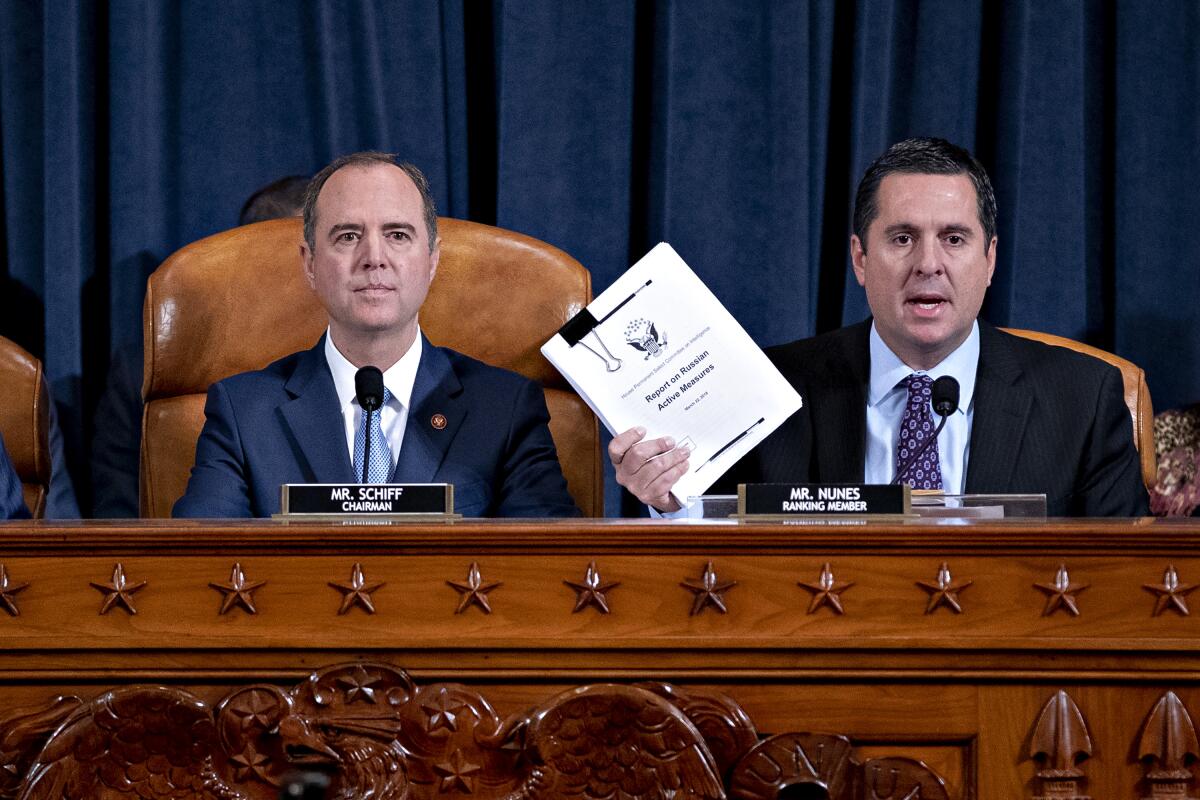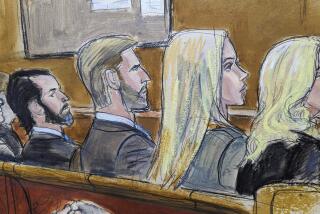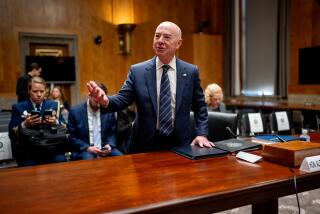Opinion: The Trump hearings haven’t connected the dots. Impeachment articles are premature

Last week artist Maurizio Cattelan reportedly sold his art piece “Comedian,” for $120,000. The work consisted of nothing more than a banana affixed to the wall with duct tape.
Some viewers of the piece saw art. Some saw hype. One person, performance artist David Datuna, saw lunch and proceeded to walk up and eat it. (It was later replaced by another banana and fresh duct tape).
Frankly, when I look at the House efforts to impeach President Trump, I see a banana taped to a wall. As others coo over the power and evidence of the report, I continue to look around scratching my head, wondering why others don’t see the obvious gaps and conflicts. Yes, we’ve heard disturbing accounts, but they are surrounded by contested facts.
To extend the art metaphor, the Democratic case is an exercise in pointillism, a painting style in which individual dots, viewed from a distance, form a picture. That is not itself improper. All cases are to some degree a mosaic of evidentiary points. But in this case, the dots are too few and the gaps too great.
That is why last week in my testimony before Congress I encouraged the Democrats to wait and build a more complete case.
Past presidential impeachments were far more Rockwellian — literal, richly detailed, non-abstract. In all three previous cases — those of Andrew Johnson, Bill Clinton and Richard Nixon — criminal acts had been clearly established and the facts surrounding them were widely accepted.
This would be the first presidential impeachment to go forward with no credible (or at least uncontested) crime at its heart. That does not mean that the Democrats’ case is necessarily invalid. The problem is that this is the thinnest record of any modern impeachment as well as arguably the shortest impeachment investigation in history (Johnson was impeached after three prior attempts and the House had been working on creating the grounds for impeachment for a year).
This would not matter if the non-criminal acts were clear and uncontested. They are not. The most serious impeachable act raised by the Democrats is abuse of power, a legitimate basis for impeachment as I stated in both the Clinton and Trump impeachment hearings. But in inexplicably rushing to an impeachment vote, the House is foregoing the subpoenaing of key witnesses who could shed light on potential abuse of power, including former national security advisor John Bolton and acting White House Chief of Staff Mick Mulvaney. Instead, the Democrats insisted we should go forward on “inferences” or interpretations rather than delay further. Yet I have looked at that banana taped to the wall from all angles, and I just don’t see how it clearly establishes a quid pro quo.
There are three direct conversations on the record. Trump’s call with Ukrainian President Volodymyr Zelensky, which does not state a clear quid pro quo. He asks for a favor, but promises nothing in return for it. Moreover, in his August conversation with Sen. Ron Johnson (R-Wis.), Trump reportedly denied any quid pro quo. In his September conversation with U.S. Ambassador to the European Union Gordon Sondland, he also denied any quid pro quo.
The House Intelligence Committee did an excellent job of undermining the final two calls by showing that Trump was already aware at the time he was speaking of the whistleblower controversy emerging on Capitol Hill. However, that does not alter the fact that those direct accounts have not been contradicted by countervailing statements from the president.
Another complication is that Zelensky himself has said that he did not discuss any quid pro quo with Trump. Moreover, the funds were released on Sept. 11 without apparent action on Ukraine’s part to do the president his requested favor. One can certainly claim that this happened only because Trump got caught. The problem is that such a claim is based on presumption rather than proof. It is guaranteed to fail on that basis in the Senate.
That is why I have suggested ways to paint a realistic case rather than impressionistic case for removal of Trump. As it stands now, with so much in the Democrats’ case relying on inference, how one views the impeachment is entirely based on one’s view of the president. That is the trouble with impressionistic impeachments: They leave too much in the eye of the beholder.
Jonathan Turley is a professor of public interest law at George Washington University and served as the last lead counsel in an impeachment trial before the Senate in defense of Judge Thomas Porteous. He also testified as a constitutional expert in both the Clinton and the Trump impeachment hearings.
More to Read
A cure for the common opinion
Get thought-provoking perspectives with our weekly newsletter.
You may occasionally receive promotional content from the Los Angeles Times.










